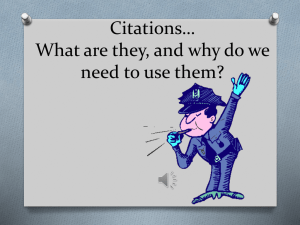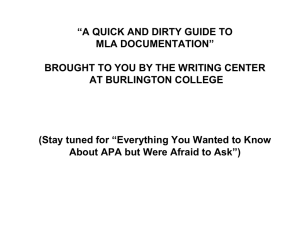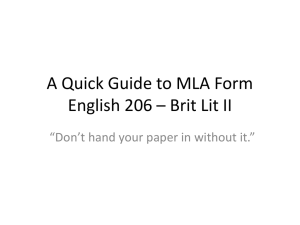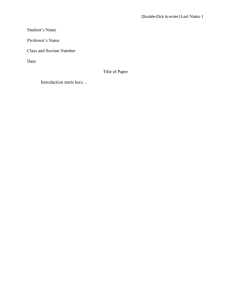MLA CITATION BASICS (Adapted from Ann Raimes` Keys for Writers
advertisement
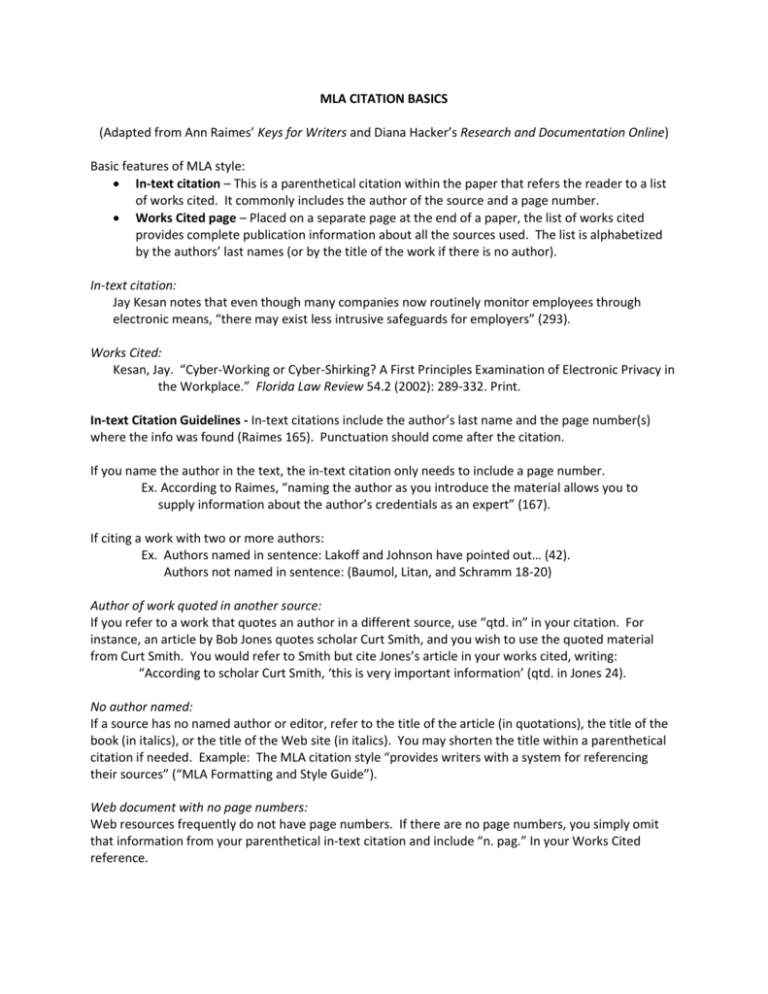
MLA CITATION BASICS (Adapted from Ann Raimes’ Keys for Writers and Diana Hacker’s Research and Documentation Online) Basic features of MLA style: In-text citation – This is a parenthetical citation within the paper that refers the reader to a list of works cited. It commonly includes the author of the source and a page number. Works Cited page – Placed on a separate page at the end of a paper, the list of works cited provides complete publication information about all the sources used. The list is alphabetized by the authors’ last names (or by the title of the work if there is no author). In-text citation: Jay Kesan notes that even though many companies now routinely monitor employees through electronic means, “there may exist less intrusive safeguards for employers” (293). Works Cited: Kesan, Jay. “Cyber-Working or Cyber-Shirking? A First Principles Examination of Electronic Privacy in the Workplace.” Florida Law Review 54.2 (2002): 289-332. Print. In-text Citation Guidelines - In-text citations include the author’s last name and the page number(s) where the info was found (Raimes 165). Punctuation should come after the citation. If you name the author in the text, the in-text citation only needs to include a page number. Ex. According to Raimes, “naming the author as you introduce the material allows you to supply information about the author’s credentials as an expert” (167). If citing a work with two or more authors: Ex. Authors named in sentence: Lakoff and Johnson have pointed out… (42). Authors not named in sentence: (Baumol, Litan, and Schramm 18-20) Author of work quoted in another source: If you refer to a work that quotes an author in a different source, use “qtd. in” in your citation. For instance, an article by Bob Jones quotes scholar Curt Smith, and you wish to use the quoted material from Curt Smith. You would refer to Smith but cite Jones’s article in your works cited, writing: “According to scholar Curt Smith, ‘this is very important information’ (qtd. in Jones 24). No author named: If a source has no named author or editor, refer to the title of the article (in quotations), the title of the book (in italics), or the title of the Web site (in italics). You may shorten the title within a parenthetical citation if needed. Example: The MLA citation style “provides writers with a system for referencing their sources” (“MLA Formatting and Style Guide”). Web document with no page numbers: Web resources frequently do not have page numbers. If there are no page numbers, you simply omit that information from your parenthetical in-text citation and include “n. pag.” In your Works Cited reference. Works Cited Guidelines – List only works cited in text of paper, not works you read but did not mention. Begin the list on a new numbered page at end of paper. List sources alphabetically by last name or name of organization. List works with no author by title. Align first line of entry with margin, and then indent all subsequent lines by half an inch. Periods separate each part of entry. Capitalize first letter of all major words in titles. Italicize the titles of books, periodicals, web sites, films, performances, etc. (Underlining is no longer used). Titles of articles, web pages, and other shorter documents go in quotation marks. Provide inclusive page numbers for articles and chapters of books. Include the publication medium (Print, Web, CD, DVD). URLs are no longer required in MLA citations. Book with one author: Fussel, Paul. Uniforms: Why We Are What We Wear. Boston: Houghton, 2002. Print. Book with Author and Editor: Bishop, Elizabeth. One Art: Letters. Ed. Robert Giroux. New York: Farrar, 1994. Print. Article in Scholarly Journal: Bhatia, Tej K. “Super-Heroes to Super-Languages: American Popular Culture through South Asian Language Comics.” World Englishes 25.2 (2006): 279-298. Print. Article in a Newspaper: Rimer, Sara. “At MIT, Large Lectures Are Going the Way of the Blackboard.” New York Times 13 Jan. 2009, late ed., A12. Print. Magazine Article in an Online Database: Lindsey, Brink. “Culture of Success.” New Republic 12 Mar. 2008: 30-31. Academic Search Premier. Web. 13 Aug. 2009. Web Source with Author: Vercammen, Paul. “Economic Troubles Bring Many to the Brink.” CNNHealth.com. Cable News Network. 28 Jan. 2009. Web. 22 March 2009. Web Source with No Author: “Polar Bears Creaking Under the Strain.” WWF. Polar Bear Tracker, World Wildlife Fund, 12 Jan. 2009. Web. 5 Feb. 2009. Online Posting on Blog, Discussion Board, etc.: Jong, Erica. “J.U. and I.” The Huffington Post. HuffingtonPost.com, Inc., 2 Feb. 2009. Web. 3 Feb. 2009. Scholarly Article in an Online Database: Lowe, Michelle S. “Britain’s Regional Shopping Centres: New Urban Forms?” Urban Studies 37.2 (2000): 261-274. Academic Search Premier. Web. 4 Feb. 2009. MLA CITATION QUICK REFERENCE GUIDE Works Cited Book with one author: Henley, Patricia. The Hummingbird House. Denver: MacMurry, 1999. Print. Book with two authors: Gillespie, Paula, and Neal Lerner. The Allyn and Bacon Guide to Peer Tutoring. Boston: Allyn, 2000. Print. Article in a Print Magazine: Buchman, Dana. “A Special Education.” Good Housekeeping Mar. 2006: 143-148. Print. Article in a Print Newspaper: Brubaker, Bill. “New Health Center Targets Country’s Uninsured Patients.” Washington Post 24 May 2007: LZ01. Print. Article in a Print Scholarly Journal: Bagchi, Alaknanda. "Conflicting Nationalisms: The Voice of the Subaltern in Mahasweta Devi's Bashai Tudu." Tulsa Studies in Women's Literature 15.1 (1996): 41-50. Print. A Page on a Website: Turner, Brooke. “How to Become Film Extras or Stand-Ins.” eHow.com. eHow.com, 30 October 2010. Web. 2 November 2010. A Page on a Website, no author named: “Diversity Affairs.” SUNY Canton. SUNY Canton, n.d. Web. 2 November 2010. Article in a Web Magazine: Bernstein, Mark. "10 Tips on Writing the Living Web." A List Apart: For People Who Make Websites. A List Apart Mag., 16 Aug. 2002. Web. 4 May 2009. Scholarly Article in an Online Database: Langhamer, Claire. “Love and Courtship in Mid-Twentieth-Century England.” Historical Journal 50.1 (2007): 173-96. ProQuest. Web. 27 May 2009. MLA IN-TEXT CITATIONS (PARENTHETICAL CITATION) – General Format: (Last name #). Examples of in-text citations for some of the references above: (Henley 241) Author name and page number available (Turner) Author available, but no page number because it is a web document (“Diversity”) Web page with no author, so use the article title (shortened if needed) in quotes (Langhamer 192) Scholarly article in an online database, so original print page numbers available *****ONLINE RESEARCH AND CITATION GUIDES***** The Online Writing Lab (OWL) at Purdue University: owl.english.purdue.edu/owl/ Diana Hacker’s Research & Documentation Online Website: bcs.bedfordstmartins.com/resdoc5e/


